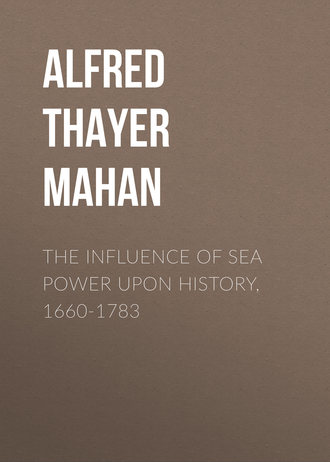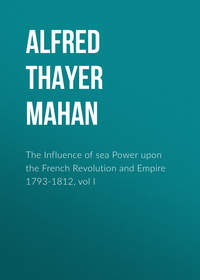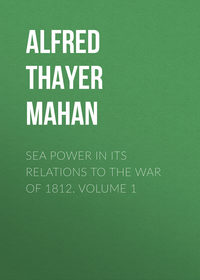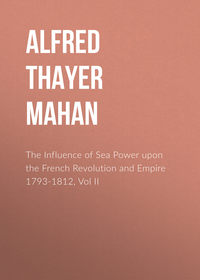 полная версия
полная версияThe Influence of Sea Power Upon History, 1660-1783
Meanwhile the two maritime States, England and Holland, though eying France distrustfully, had greater and growing grudges against each other, which under the fostering care of Charles II. led to war. The true cause was doubtless commercial jealousy, and the conflict sprang immediately from collisions between the trading companies. Hostilities began on the west coast of Africa; and an English squadron, in 1664, after subduing several Dutch stations there, sailed to New Amsterdam (now New York), and seized it. All these affairs took place before the formal declaration of war in February, 1665. This war was undoubtedly popular in England; the instinct of the people found an expression by the lips of Monk, who is reported to have said, "What matters this or that reason? What we want is more of the trade which the Dutch now have." There is also little room to doubt that, despite the pretensions of the trading companies, the government of the United Provinces would gladly have avoided the war; the able man who was at their head saw too clearly the delicate position in which they stood between England and France. They claimed, however, the support of the latter in virtue of a defensive treaty made in 1662. Louis allowed the claim, but unwillingly; and the still young navy of France gave practically no help.
The war between the two sea States was wholly maritime, and had the general characteristics of all such wars. Three great battles were fought,—the first off Lowestoft, on the Norfolk coast, June 13, 1665; the second, known as the Four Days' Battle in the Straits of Dover, often spoken of by French writers as that of the Pas de Calais, lasting from the 11th to the 14th of June, 1666; and the third, off the North Foreland, August 4 of the same year. In the first and last of these the English had a decided success; in the second the advantage remained with the Dutch. This one only will be described at length, because of it alone has been found such a full, coherent account as will allow a clear and accurate tactical narrative to be given. There are in these fights points of interest more generally applicable to the present day than are the details of somewhat obsolete tactical movements.
In the first battle off Lowestoft, it appears that the Dutch commander, Opdam, who was not a seaman but a cavalry officer, had very positive orders to fight; the discretion proper to a commander-in-chief on the spot was not intrusted to him. To interfere thus with the commander in the field or afloat is one of the most common temptations to the government in the cabinet, and is generally disastrous. Tourville, the greatest of Louis XIV.'s admirals, was forced thus to risk the whole French navy against his own judgment; and a century later a great French fleet escaped from the English admiral Keith, through his obedience to imperative orders from his immediate superior, who was sick in port.
In the Lowestoft fight the Dutch van gave way; and a little later one of the junior admirals of the centre, Opdam's own squadron, being killed, the crew was seized with a panic, took the command of the ship from her officers, and carried her out of action. This movement was followed by twelve or thirteen other ships, leaving a great gap in the Dutch line. The occurrence shows, what has before been pointed out, that the discipline of the Dutch fleet and the tone of the officers were not high, despite the fine fighting qualities of the nation, and although it is probably true that there were more good seamen among the Dutch than among the English captains. The natural steadfastness and heroism of the Hollanders could not wholly supply that professional pride and sense of military honor which it is the object of sound military institutions to encourage. Popular feeling in the United States is pretty much at sea in this matter; there is with it no intermediate step between personal courage with a gun in its hand and entire military efficiency.
Opdam, seeing the battle going against him, seems to have yielded to a feeling approaching despair. He sought to grapple the English commander-in-chief, who on this day was the Duke of York, the king's brother. He failed in this, and in the desperate struggle which followed, his ship blew up. Shortly after, three, or as one account says four, Dutch ships ran foul of one another, and this group was burned by one fire-ship; three or four others singly met the same fate a little later. The Dutch fleet was now in disorder, and retreated under cover of the squadron of Van Tromp, son of the famous old admiral who in the days of the Commonwealth sailed through the Channel with a broom at his masthead.
Fire-ships are seen here to have played a very conspicuous part, more so certainly than in the war of 1653, though at both periods they formed an appendage to the fleet. There is on the surface an evident resemblance between the rôle of the fire-ship and the part assigned in modern warfare to the torpedo-cruiser. The terrible character of the attack, the comparative smallness of the vessel making it, and the large demands upon the nerve of the assailant, are the chief points of resemblance; the great points of difference are the comparative certainty with which the modern vessel can be handled, which is partly met by the same advantage in the iron-clad over the old ship-of-the-line, and the instantaneousness of the injury by torpedo, whose attack fails or succeeds at once, whereas that of the fire-ship required time for effecting the object, which in both cases is total destruction of the hostile ship, instead of crippling or otherwise reducing it. An appreciation of the character of fire-ships, of the circumstances under which they attained their greatest usefulness, and of the causes which led to their disappearance, may perhaps help in the decision to which nations must come as to whether the torpedo-cruiser, pure and simple, is a type of weapon destined to survive in fleets.
A French officer, who has been examining the records of the French navy, states that the fire-ship first appears, incorporated as an arm of the fleet, in 1636.
"Whether specially built for the purpose, or whether altered from other purposes to be fitted for their particular end, they received a special equipment. The command was given to officers not noble, with the grade of captain of fire-ship. Five subordinate officers and twenty-five seamen made up the crew. Easily known by grappling-irons which were always fitted to their yards, the fire-ship saw its rôle growing less in the early years of the eighteenth century. It was finally to disappear from the fleets whose speed it delayed and whose evolutions were by it complicated. As the ships-of-war grew larger, their action in concert with fire-ships became daily more difficult. On the other hand, there had already been abandoned the idea of combining them with the fighting-ships to form a few groups, each provided with all the means of attack and defence. The formation of the close-hauled line-of-battle, by assigning the fire-ships a place in a second line placed half a league on the side farthest from the enemy, made them more and more unfitted to fulfil their office. The official plan of the battle of Malaga (1704), drawn up immediately after the battle, shows the fire-ship in this position as laid down by Paul Hoste. Finally the use of shells, enabling ships to be set on fire more surely and quickly, and introduced on board at the period of which we are now treating, though the general use did not obtain until much later, was the last blow to the fire-ship."20
Those who are familiar with the theories and discussions of our own day on the subject of fleet tactics and weapons, will recognize in this short notice of a long obsolete type certain ideas which are not obsolete. The fire-ship disappeared from fleets "whose speed it delayed." In heavy weather small bulk must always mean comparatively small speed. In a moderate sea, we are now told, the speed of the torpedo-boat falls from twenty knots to fifteen or less, and the seventeen to nineteen knot cruiser can either run away from the pursuing boats, or else hold them at a distance under fire of machine and heavy guns. These boats are sea-going, "and it is thought can keep the sea in all weathers; but to be on board a 110-foot torpedo-boat, when the sea is lively, is said to be far from agreeable. The heat, noise, and rapid vibrations of the engines are intense. Cooking seems to be out of the question, and it is said that if food were well cooked few would be able to appreciate it. To obtain necessary rest under these conditions, added to the rapid motions of the boat, is most difficult." Larger boats are to be built; but the factor of loss of speed in rough weather will remain, unless the size of the torpedo-cruiser is increased to a point that will certainly lead to fitting them with something more than torpedoes. Like fire-ships, small torpedo-cruisers will delay the speed and complicate the evolutions of the fleet with which they are associated.21 The disappearance of the fire-ship was also hastened, we are told, by the introduction of shell firing, or incendiary projectiles; and it is not improbable that for deep-sea fighting the transfer of the torpedo to a class of larger ships will put an end to the mere torpedo-cruiser. The fire-ship continued to be used against fleets at anchor down to the days of the American Civil War; and the torpedo-boat will always be useful within an easy distance of its port.
A third phase of naval practice two hundred years ago, mentioned in the extract quoted, involves an idea very familiar to modern discussions; namely, the group formation. "The idea of combining fire-ships with the fighting-ships to form a few groups, each provided with all the means of attack and defence," was for a time embraced; for we are told that it was later on abandoned. The combining of the ships of a fleet into groups of two, three, or four meant to act specially together is now largely favored in England; less so in France, where it meets strong opposition. No question of this sort, ably advocated on either side, is to be settled by one man's judgment, nor until time and experience have applied their infallible tests. It may be remarked, however, that in a well-organized fleet there are two degrees of command which are in themselves both natural and necessary, that can be neither done away nor ignored; these are the command of the whole fleet as one unit, and the command of each ship as a unit in itself. When a fleet becomes too large to be handled by one man, it must be subdivided, and in the heat of action become practically two fleets acting to one common end; as Nelson, in his noble order at Trafalgar, said, "The second in command will, after my intentions are made known to him" (mark the force of the "after," which so well protects the functions both of the commander-in-chief and the second), "have the entire direction of his line, to make the attack upon the enemy, and to follow up the blow until they are captured or destroyed."
The size and cost of the individual iron-clad of the present day makes it unlikely that fleets will be so numerous as to require subdivision; but whether they are or not does not affect the decision of the group question. Looking simply to the principle underlying the theory, and disregarding the seeming tactical clumsiness of the special groups proposed, the question is: Shall there be introduced between the natural commands of the admiral and of the captains of individual ships a third artificial contrivance, which on the one hand will in effect partly supersede the supreme authority, and on the other will partly fetter the discretion of commanders of ships? A further difficulty springing from the narrow principle of support specially due to particular ships, on which the group system rests, is this: that when signals can no longer be seen, the duty of the captain to his own ship and to the fleet at large will be complicated by his duty to observe certain relations to particular ships; which particular ships must in time come to have undue prominence in his views. The group formation had its day of trial in old times, and disappeared before the test of experience; whether in its restored form it will survive, time will show. It may be said, before quitting the subject, that as an order of sailing, corresponding to the route-step of an army in march, a loose group formation has some advantages; maintaining some order without requiring that rigid exactness of position, to observe which by day and night must be a severe strain on captain and deck-officers. Such a route-order should not, however, be permitted until a fleet has reached high tactical precision.
To return to the question of fire-ships and torpedo-boats, the rôle of the latter, it is often said, is to be found in that mêlée which is always to succeed a couple of headlong passes between the opposing fleets. In the smoke and confusion of that hour is the opportunity of the torpedo-boat. This certainly sounds plausible, and the torpedo vessel certainly has a power of movement not possessed by the fire-ship. A mêlée of the two fleets, however, was not the condition most favorable for the fire-ship. I shall quote here from another French officer, whose discussion of these Anglo-Dutch sea-fights, in a late periodical, is singularly clear and suggestive. He says:
"Far from impeding the direct action of the fire-ship, which was naught or nearly so during the confused battles of the war of 1652, the regularity and ensemble newly attained in the movements of squadrons seem rather to favor it. The fire-ships played a very important part at the battles of Lowestoft, Pas de Calais, and the North Foreland. Thanks to the good order preserved by the ships-of-the-line, these incendiary ships can indeed be better protected by the artillery; much more efficiently directed than before toward a distinct and determined end."22
In the midst of the confused mêlées of 1652 the fire-ship "acted, so to speak, alone, seeking by chance an enemy to grapple, running the risk of a mistake, without protection against the guns of the enemy, nearly sure to be sunk by him or else burned uselessly. All now, in 1665, has become different. Its prey is clearly pointed out; it knows it, follows it easily into the relatively fixed position had by it in the enemy's line. On the other hand, the ships of his own division do not lose sight of the fire-ship. They accompany it as far as possible, cover it with their artillery to the end of its course, and disengage it before burning, if the fruitlessness of the attempt is seen soon enough. Evidently under such conditions its action, always uncertain (it cannot be otherwise), nevertheless acquires greater chances of success." These instructive comments need perhaps the qualifying, or additional, remark that confusion in the enemy's order at the time that your own remains good gives the best opening for a desperate attack. The writer goes on to trace the disappearance of the fire-ship:—
"Here then we see the fire-ship at the point of its highest importance. That importance will decrease, the fire-ship itself will end by disappearing from engagements in the open sea, when naval artillery becoming more perfect shall have greater range, be more accurate and more rapid;23 when ships receiving better forms, greater steering power, more extensive and better balanced sail power, shall be able, thanks to quicker speed and handling, to avoid almost certainly the fire-ships sent against them; when, finally, fleets led on principles of tactics as skilful as they were timid, a tactics which will predominate a century later during the whole war of American Independence, when these fleets, in order not to jeopardize the perfect regularity of their order of battle, will avoid coming to close quarters, and will leave to the cannon alone to decide the fate of an action."
In this discussion the writer has in view the leading feature which, while aiding the action of the fire-ship, also gives this war of 1665 its peculiar interest in the history of naval tactics. In it is found for the first time the close-hauled line-of-battle undeniably adopted as the fighting order of the fleets. It is plain enough that when those fleets numbered, as they often did, from eighty to a hundred ships, such lines would be very imperfectly formed in every essential, both of line and interval; but the general aim is evident, amid whatever imperfections of execution. The credit for this development is generally given to the Duke of York, afterward James II.; but the question to whom the improvement is due is of little importance to sea-officers of the present day when compared with the instructive fact that so long a time elapsed between the appearance of the large sailing-ship, with its broadside battery, and the systematic adoption of the order which was best adapted to develop the full power of the fleet for mutual support. To us, having the elements of the problem in our hands, together with the result finally reached, that result seems simple enough, almost self-evident. Why did it take so long for the capable men of that day to reach it? The reason—and herein lies the lesson for the officer of to-day—was doubtless the same that leaves the order of battle so uncertain now; namely, that the necessity of war did not force men to make up their minds, until the Dutch at last met in the English their equals on the sea. The sequence of ideas which resulted in the line-of-battle is clear and logical. Though familiar enough to seamen, it will be here stated in the words of the writer last quoted, because they have a neatness and precision entirely French:—
"With the increase of power of the ship-of-war, and with the perfecting of its sea and warlike qualities, there has come an equal progress in the art of utilizing them.... As naval evolutions become more skilful, their importance grows from day to day. To these evolutions there is needed a base, a point from which they depart and to which they return. A fleet of war-ships must be always ready to meet an enemy; logically, therefore, this point of departure for naval evolutions must be the order of battle. Now, since the disappearance of galleys, almost all the artillery is found upon the sides of a ship of war. Hence it is the beam that must necessarily and always be turned toward the enemy. On the other hand, it is necessary that the sight of the latter must never be interrupted by a friendly ship. Only one formation allows the ships of the same fleet to satisfy fully these conditions. That formation is the line ahead [column]. This line, therefore, is imposed as the only order of battle, and consequently as the basis of all fleet tactics. In order that this order of battle, this long thin line of guns, may not be injured or broken at some point weaker than the rest, there is at the same time felt the necessity of putting in it only ships which, if not of equal force, have at least equally strong sides. Logically it follows, at the same moment in which the line ahead became definitively the order for battle, there was established the distinction between the ships 'of the line,' alone destined for a place therein, and the lighter ships meant for other uses."
If to these we add the considerations which led to making the line-of-battle a close-hauled line, we have the problem fully worked out. But the chain of reasoning was as clear two hundred and fifty years ago as it is now; why then was it so long in being worked out? Partly, no doubt, because old traditions—in those days traditions of galley-fighting—had hold of and confused men's minds; chiefly because men are too indolent to seek out the foundation truths of the situation in their day, and develop the true theory of action from its base up. As a rare instance of clear-sightedness, recognizing such a fundamental change in conditions and predicting results, words of Admiral Labrousse of the French navy, written in 1840, are most instructive. "Thanks to steam," he wrote, "ships will be able to move in any direction with such speed that the effects of collision may, and indeed must, as they formerly did, take the place of projectile weapons and annul the calculations of the skilful manœuvrer. The ram will be favorable to speed, without destroying the nautical qualities of a ship. As soon as one power shall have adopted this terrible weapon, all others must accept it, under pain of evident inferiority, and thus combats will become combats of ram against ram." While forbearing the unconditional adhesion to the ram as the controlling weapon of the day, which the French navy has yielded, the above brief argument may well be taken as an instance of the way in which researches into the order of battle of the future should be worked out. A French writer, commenting on Labrousse's paper, says:—
"Twenty-seven years were scarce enough for our fathers, counting from 1638, the date of building the 'Couronne,' to 1665, to pass from the tactical order of the line abreast, the order for galleys, to that of the line ahead. We ourselves needed twenty-nine years from 1830, when the first steamship was brought into our fleet, to 1859, when the application of the principle of ram-fighting was affirmed by laying down the 'Solferino' and the 'Magenta' to work a revolution in the contrary direction; so true it is that truth is always slow in getting to the light.... This transformation was not sudden, not only because the new material required time to be built and armed, but above all, it is sad to say, because the necessary consequences of the new motive power escaped most minds."24
We come now to the justly celebrated Four Days' Battle of June, 1666, which claims special notice, not only on account of the great number of ships engaged on either side, nor yet only for the extraordinary physical endurance of the men who kept up a hot naval action for so many successive days, but also because the commanders-in-chief on either side, Monk and De Ruyter, were the most distinguished seamen, or rather sea-commanders, brought forth by their respective countries in the seventeenth century. Monk was possibly inferior to Blake in the annals of the English navy; but there is a general agreement that De Ruyter is the foremost figure, not only in the Dutch service, but among all the naval officers of that age. The account about to be given is mainly taken from a recent number of the "Revue Maritime et Coloniale,"25 and is there published as a letter, recently discovered, from a Dutch gentleman serving as volunteer on board De Ruyter's ship, to a friend in France. The narrative is delightfully clear and probable,—qualities not generally found in the description of those long-ago fights; and the satisfaction it gave was increased by finding in the Memoirs of the Count de Guiche, who also served as volunteer in the fleet, and was taken to De Ruyter after his own vessel had been destroyed by a fire-ship, an account confirming the former in its principal details.26 This additional pleasure was unhappily marred by recognizing certain phrases as common to both stories; and a comparison showed that the two could not be accepted as independent narratives. There are, however, points of internal difference which make it possible that the two accounts are by different eye-witnesses, who compared and corrected their versions before sending them out to their friends or writing them in their journals.
The numbers of the two fleets were: English about eighty ships, the Dutch about one hundred; but the inequality in numbers was largely compensated by the greater size of many of the English. A great strategic blunder by the government in London immediately preceded the fight. The king was informed that a French squadron was on its way from the Atlantic to join the Dutch. He at once divided his fleet, sending twenty ships under Prince Rupert to the westward to meet the French, while the remainder under Monk were to go east and oppose the Dutch.
A position like that of the English fleet, threatened with an attack from two quarters, presents one of the subtlest temptations to a commander. The impulse is very strong to meet both by dividing his own numbers as Charles did; but unless in possession of overwhelming force it is an error, exposing both divisions to be beaten separately, which, as we are about to see, actually happened in this case. The result of the first two days was disastrous to the larger English division under Monk, which was then obliged to retreat toward Rupert; and probably the opportune return of the latter alone saved the English fleet from a very serious loss, or at the least from being shut up in their own ports. A hundred and forty years later, in the exciting game of strategy that was played in the Bay of Biscay before Trafalgar, the English admiral Cornwallis made precisely the same blunder, dividing his fleet into two equal parts out of supporting distance, which Napoleon at the time characterized as a glaring piece of stupidity. The lesson is the same in all ages.









